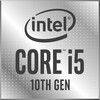Intel Core i5-1030NG7 vs Apple M1 Pro 8-Core vs Apple M1
Intel Core i5-1030NG7
► remove from comparison
The Intel Core i5-1030NG7 is a power efficient quad-core SoC for laptops and Ultrabooks based on the Ice -Lake-Y generation that was announced in Mai 2019 (Computex). It integrates four Sunnycove processor cores (8 threads thanks to HyperThreading) clocked at 1.1 (base) - 3.8 (single core Turbo) GHz. All four cores can turbo up to 3.2 GHz using Turbo Boost. According to Intel the Sunnycove cores achieve 18% more IPCs (Instructions per Clock).
Compared to the normal Core i5-1030G7, the i5-1030NG7 offers a smaller package size (22 x 16.5 versus 26.5 x 18.5 mm), a higher base clock of 1100 versus 800 MHz and a 1 Watt higher TDP.
Combined with the two additional cores, the previous Y-series dual core processors (Amber Lake-Y) should be always slower. Short burst performance should be excellent, long workloads will depend on the TDP settings and cooling solution in the laptop / tablet.
The biggest improvement for Ice-Lake is the integrated Gen 11 graphics card called Iris Plus Graphics. The Core i5-1030NG7 integrates the biggest G7 variant with 64 CUs clocked at 300 - 1050 MHz. The Iris Plus G7 should be twice as fast as the predecessors and best the AMD Vega 10 GPU in current Ryzen APUs. However, in the Y-series the gaming performance will be again depending on the cooling solution and may degrade clearly over time (compared to the Core i7-1065G7 with 15 - 25 Watt e.g.).
Other improvements for Ice Lake are the AI hardware acceleration and the partial integration of Thunderbolt and Wifi 6 in the chip. The integrated DDR4 memory controller supports modules with up to 3200 MHz (and LPDDDR4 3733).
The Core i5-1030NG7 is produced in the new 10nm process at Intel (2nd generation) that should offer a comparable performance to the 7nm process at TSMC. The TDP is specified at 10 Watts and therefore the CPU can be used in thin and light laptops. Intel offers a configurable TDP of up to 12 Watts for the partners resulting in significant performance differences (due to longer periods of Turbo Boost).
Apple M1 Pro 8-Core
► remove from comparison
The Apple M1 Pro 8-Core is a System on a Chip (SoC) from Apple that is found in the late 2021 MacBook Pro 14 and 16-inch models. It offers 8 cores from the 10 available in the chip divided in six performance cores (P-cores with 600 - 3220 MHz) and four power-efficiency cores (E-cores with 600 - 2064 MHz). The cores are similar to the cores in the Apple M1.
The big cores (codename Firestorm) offer 192 KB instruction cache, 128 KB data cache, and 24 MB shared L2 cache (up from 12 MB in the M1). The four efficiency cores (codename Icestorm) are a lot smaller and offer only 128 KB instruction cache, 64 KB data cache, and 4 MB shared cache. Finally, the SoC includes 16 MB System Level Cache shared by the GPU. The efficiency cores (E cluster) clock with 600 - 2064 MHz, the performance cores (P cluster) with 600 - 3228 MHz.
The unified memory (16 or 32 GB LPDDR5-6400) next to the chip is connected by a 256 bit memory controller and can be used by the GPU and CPU.
The integrated graphics card in the M1 Pro offers 14 cores (of the 16 cores in the chip).
Furthermore, the SoC integrates a fast 16 core neural engine, a secure enclave (e.g., for encryption), a unified memory architecture, Thunderbolt 4 controller, an ISP, and media de- and encoders (including ProRes).
The M1 Pro is manufactured in 5 nm at TSMC and integrates 33.7 billion transistors. The peak power consumption of the chip was advertised around 30W for CPU intensive tasks.
Apple M1
► remove from comparison
The Apple M1 is a System on a Chip (SoC) from Apple that is found in the late 2020 MacBook Air, MacBook Pro 13, and Mac Mini. It offers 8 cores divided in four performance cores and four power-efficiency cores. The big cores offer 192 KB instruction cache, 128 KB data cache, and 12 MB shared L2 cache. According to Apple the performance of these cores should be better than anything on the market (in late 2020). The four efficiency cores are a lot smaller and offer only 128 KB instruction cache, 64 KB data cache, and 4 MB shared cache. The efficiency cores (E cluster) clock with 600 - 2064 MHz, the performance cores (P cluster) with 600 - 3204 MHz.
The M1 is available in two TDP variants, a passive cooled 10 Watt variant for the MacBook Air and an active cooled faster variant for the MacBook Pro 13 and Mac Mini. Those should offer a better-sustained performance according to Apple.
The integrated graphics card in the M1 offers 8 cores (7 cores in the entry MacBook Air) and a peak performance of 2.6 teraflops. Apple claims that it is faster than any other iGPU at the time of announcement.
Furthermore, the SoC integrates a fast 16 core neural engine with a peak performance of 11 TOPS (for AI hardware acceleration), a secure enclave (e.g., for encryption), a unified memory architecture, Thunderbolt / USB 4 controller, an ISP, and media de- and encoders.
The Apple M1 includes 16 billion transistors (up from the 10 billion of the A12Z Bionic and therefore double the amount of a Tiger Lake-U chip like the i7-1185G7) and is manufactured in 5nm at TSMC.
| Model | Intel Core i5-1030NG7 | Apple M1 Pro 8-Core | Apple M1 | ||||||||||||||||||||||||||||||||||||||||||||||||
| Codename | Ice Lake Y | ||||||||||||||||||||||||||||||||||||||||||||||||||
| Series | Intel Ice Lake | Apple M1 | Apple M1 | ||||||||||||||||||||||||||||||||||||||||||||||||
| Series: M1 |
|
|
| ||||||||||||||||||||||||||||||||||||||||||||||||
| Clock | 1100 - 3500 MHz | 2060 - 3220 MHz | 2064 - 3220 MHz | ||||||||||||||||||||||||||||||||||||||||||||||||
| L1 Cache | 192 KB | 2.3 MB | 2 MB | ||||||||||||||||||||||||||||||||||||||||||||||||
| L2 Cache | 2 MB | 28 MB | 16 MB | ||||||||||||||||||||||||||||||||||||||||||||||||
| L3 Cache | 6 MB | 16 MB | 8 MB | ||||||||||||||||||||||||||||||||||||||||||||||||
| Cores / Threads | 4 / 8 | 8 / 8 | 8 / 8 | ||||||||||||||||||||||||||||||||||||||||||||||||
| TDP | 10 Watt | ||||||||||||||||||||||||||||||||||||||||||||||||||
| Technology | 10 nm | 5 nm | 5 nm | ||||||||||||||||||||||||||||||||||||||||||||||||
| Features | AVX512, DL Boost, Turbo Boost 2.0 | ARMv8 Instruction Set | ARMv8 Instruction Set | ||||||||||||||||||||||||||||||||||||||||||||||||
| iGPU | Intel Iris Plus Graphics G7 (Ice Lake 64 EU) (300 - 1050 MHz) | Apple M1 Pro 14-Core GPU ( - 1296 MHz) | Apple M1 8-Core GPU | ||||||||||||||||||||||||||||||||||||||||||||||||
| Architecture | x86 | ARM | ARM | ||||||||||||||||||||||||||||||||||||||||||||||||
| Announced | |||||||||||||||||||||||||||||||||||||||||||||||||||
| Transistors | 33700 Million | 16000 Million |
Benchmarks
Average Benchmarks Intel Core i5-1030NG7 → 100% n=8
Average Benchmarks Apple M1 Pro 8-Core → 219% n=8
Average Benchmarks Apple M1 → 191% n=8
* Smaller numbers mean a higher performance
1 This benchmark is not used for the average calculation












